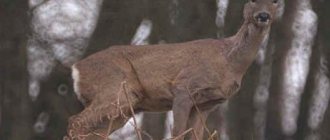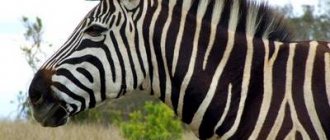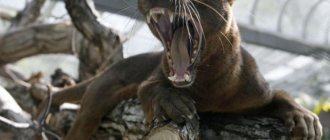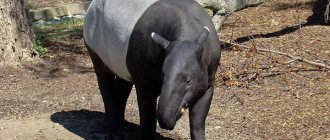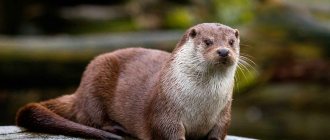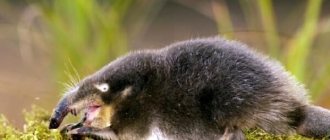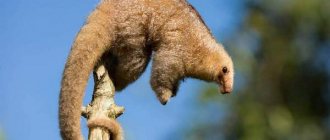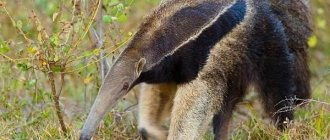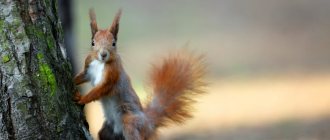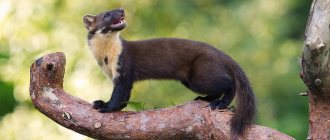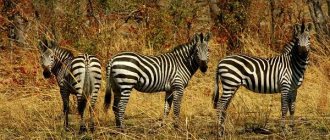Description of the roe deer
Roe deer is a small-sized deer. Males have small, double-branched horns. They appear in the second year of the animal’s life. In late spring, males always rub their antlers against trees to get rid of dead skin on them. The summer coat is dark red in color, the winter coat is gray-brown, thick, there is a white spot near the small tail. The same spots may be in the throat area. The muzzle is gray with black stripes from the nose to the corners of the lips.
Feeding characteristics of roe deer
— Advertising —
The roe deer is a herbivore, grazing early in the morning and at dusk. Its diet includes grass, young buds and tree leaves. Food is grasped with the help of the lower incisors and a hard chewing ridge on top and bitten off. In the autumn, when there is little grass, roe deer also eat nuts and other forest fruits (acorns, chestnuts, blueberries, sea buckthorn, beech fruits). Acorns, rutabaga, etc. are added to the winter diet. During severe frosts, roe deer gnaw young branches from trees.
Animal diet
During the warm period of spring and summer, roe deer live alone. It was during warm weather that the largest number of photos of roe deer were taken. During this mating season, the animal is individually responsible for comfort in its personal territory. Roe deer choose places densely overgrown with grass and bushes. In addition to the opportunity to eat plenty, herbivores in the thickets take refuge from the heat. Eat fruits and berries:
- blueberries and lingonberries;
- bird cherry and blueberry;
- apples and pears (picked from the ground);
- mushrooms.
When the free period ends, the animals have a hard time. The diet includes:
- bark from trees;
- dried roots;
- shoots of coniferous trees;
- rowan and viburnum.
Finding itself in snowy areas, the roe deer, having eaten all the vegetation still remaining on the surface, will dig through the snow in search of dried grass.
In captivity, roe deer live in zoos and nature reserves. The animals are fed grass, acorns and hay (in the cold season). There is a known case when a man found a month-old roe deer calf. At the zoo, veterinarians determined the age when the roe deer began to browse grass. The baby was also fed bananas and milk.
The article contains photographs of roe deer taken in nature reserves.
On average, animals live 8-10 years in the wild, and 12-13 years under supervision.
Roe deer distribution
The roe deer's habitat includes a strip of temperate climates in Europe and Asia to the Far East and Korea. In the west, it is found mainly the European roe deer (Capreolus Capreolus), in the eastern regions - the Siberian roe deer (Capreolus pygargus). For life, it prefers deciduous and mixed forests, as well as open areas, forest-steppes, and is found in the mountains up to a strip of eternal snow.
Habitat
If we talk about habitat, roe deer prefer forest-steppe and small islands of forests among arable lands. They love tall grass and meadows with bushes. In addition, they like islands of land left after deforestation, which serve for reclamation. They also love tall grass and meadows with bushes.
The Siberian roe deer occupies a wide range of habitats, including deciduous, mixed or coniferous forests, swamps, pastures, and arable lands in suburban areas with large gardens. And you've probably already guessed who prefers landscapes with a mosaic of forests and is well adapted to modern agricultural landscapes? That's right - Siberian roe deer. The photos in the article show this perfectly.
Common types of roe deer
- European roe deer, roe deer or wild goat (Capreоlus capreоlus)
Small graceful deer.
The body is short, the body is higher at the back than at the front. Males weigh from 22 to 32 kg, body length is 108-126 cm, height from 66 to 81 cm. Females are slightly inferior to males in size. The head is short, wide, tapering towards the nose. The ears are long, oval or pointed. The eyes are large and protruding. The neck is long. The limbs are long and thin. The tail is very small, up to 2-3 cm in length. The hooves are narrow and short. The horns of males are 15-30 cm long with three branches. Females do not have horns.
— Advertising —
Adult European roe deer are uniformly colored. In winter, they are gray or grayish-brown, less often grayish-red, and brownish-brown behind. The bottom of the body is light or yellowish-cream. The tail is surrounded by a white or light reddish spot. The legs become red at the bottom. The head and ears are red or brown. There is a white spot on the chin, and a black or gray-brown “whisker” stretches from the nose to the lips. Summer fur is uniformly red, the belly is whitish-red, the head is gray with a reddish tint and mustache.
- Siberian roe deer (Capreоlus pygargus)
The species differs from its European relative in its larger size (body length 126-144 cm, height from 82 to 94 cm, weight 32-48 kg) and long horns (27-33 cm).
The summer fur on the head is not gray, but red, the same color as the sides and back. The Siberian roe deer is distributed more east than the European one (Trans-Volga region, the Urals, Siberia, the Far East, Yakutia, Central Asia, China, Mongolia).
"Protected" status
Despite the fairly extensive habitat and excessive numbers of roe deer in some countries, including negative consequences (frequent road accidents), the Siberian roe deer is in the Red Book. The reasons for such a ban were: insignificant remnants of the population, as well as the threat of poaching and predation. Rare representatives of this species of Siberian animals are in serious danger of extinction due to habitat loss, weather conditions and the consequences of human activity. Today, roe deer are widely protected in the UK. Some methods of killing or taking deer are prohibited under Annex IV of the Berne Convention and are punishable by law. In addition to the above, it is known that measures are also being taken on the territory of the Russian Federation to combat poaching and to rationally manage hunting in order to restore and increase the number of Siberian roe deer. This beautiful representative of the animal world is listed in the Red Books of the Tomsk Region and Krasnoyarsk Territory. The fine imposed on the violator of the order for roe deer varies depending on the severity of the damage caused, and is determined individually and in accordance with the law. It can be up to five times the minimum wage.
Roe deer behavior
In Europe, roe deer lead a sedentary lifestyle, occasionally changing pastures.
In winter, they move to areas where there is less snow and there are bushes and young bushes. Populations living in the mountains migrate seasonally. In winter, they descend lower in search of food. Roe deer live either singly or in herds of up to 10 individuals. They are active in the morning and at dusk, at which time they can often be seen. In case of danger, the animal raises its head and looks carefully in the direction of suspicious sounds, also pointing its ears there.
European roe deer , roe deer , wild goat or simply roe deer (lat. Capreólus capreólus) is an artiodactyl animal of the deer family. The roe deer lives throughout Europe and is also found in the Caucasus and the Middle East. The diet of a wild goat consists of a huge variety of plant foods. Average sizes of European roe deer: males - body length 1.08-1.3 m, height at withers 66-91 cm, body weight 22-37 kg. Females are approximately 15-16% . It is the object of commercial and sport hunting. Life expectancy is 12-16 years.
Content:
1. Appearance and physique
2. Habits and lifestyle
3. Reproduction
4. Natural enemies of roe deer in Crimea
5. Roe deer hunting in Crimea
Appearance and physique
The size and weight of roe deer are subject, in addition to significant age, gender and seasonal differences, to great geographical variability. The largest representatives of this species live in Sweden, east of the Dnieper and the mountains of the North Caucasus. The European roe deer also has a related species - the Siberian roe deer .
The main difference between these species is the size; the Siberian roe deer is much larger than the European one. The European roe deer has an appearance typical of a cervid. The body is not long, as mentioned above, only 108-130 cm. The tail is small from 2 to 3.5 cm and it is barely noticeable due to the fur of the near-tail “mirror”. The white “mirror” appears in animals in September, after molting, and lasts until the summer molting. The animal's limbs are long and thin, and the hind legs are slightly longer than the front ones, because of this the wild goat's back is tilted forward and the sacrum, it turns out, is slightly higher than the withers. Small hooves. The head is short, but rather wide and high around the eyes. It tapers from the ears to the nose. The ears are oval-shaped, pointed towards the top, they reach a length of up to 14 cm. The eyes are large and bulging, the pupils sit obliquely. The neck is long and thin.
On the legs there are interdigital (interungulate) and metatarsal (located on the outer side of the hind legs) glands, consisting of sebaceous and sweat glands, with their help a secret remains on the animal’s trail, telling its relatives all the necessary information about its owner - physiological condition, age, gender . In this way, roe deer can find members of their group, females during the rut, and rivals coveting someone else’s territory.
In males, the sebaceous and sweat glands on the head and neck, from the beginning of spring to the end of summer, significantly increase. With their help, males mark their territory, warning male rivals that the territory is occupied, and females that there is a male here who is ready to reproduce.
The main sign of sexual dimorphism is horns . An adult male grows small horns, 15-30 cm long and up to 10-15 cm wide. They are slightly curved and stand almost vertically, can have up to 3 branches, and are also covered with many tubercles (so-called “pearls”). . In the development of horns, sometimes anomalies occur; there are cases of uneven development of the left or right horn.
Horns begin to grow in males from 4 months of age, but they reach their final development only by the 3rd year of the animal’s life.
Like deer, roe deer shed their antlers every year. This occurs from October to December, then after about a month new ones begin to grow, growing to full size by April. In May, the antlers finally ossify and the males begin to actively rub them against the trees, clearing them of remnants of skin.
Females do not grow horns, however, there are very rare exceptions, and the horns grow small and ugly.
The roe deer has a very well developed sense of smell and hearing , vision is also quite well developed, however, it does not allow animals to clearly distinguish colors in the spectrum of medium and long waves (red, orange, yellow, green), but they perfectly distinguish colors in the range of short light waves (blue , violet, especially ultraviolet).
The color of adult animals is one-color, without sexual dimorphism; in the warm season it is light brown with a reddish tint, and in the cold season it is grayish-brown. The back part of the body, in the tail area (the so-called “mirror”), is painted white. Downwards the color of the body gradually becomes lighter. The abdomen is light. There is a light spot on the chin.
In small roe deer, so that they can camouflage among vegetation, the body is decorated with light sandy or grayish spots located in three longitudinal rows on each side of the body, while the overall color of the animal is reddish-yellow or sandy with a light brown tint. The abdomen and legs have a lighter shade.
A wild goat sheds twice a year. When switching to summer hair - in April-May, however, in elderly and sick animals the molting process is delayed, for example, in an emaciated, middle-aged male, the remnants of winter hair may linger until June-July. The transition to winter wool begins at the end of summer, around August, during this period the winter wool begins to grow, and the summer wool slowly falls out. The winter molting process continues until the beginning of October.
Habits, lifestyle and behavioral characteristics
Roe deer live in a variety of deciduous and mixed forests, as well as in forest-steppes. When choosing a place to live, they give preference to spacious and light forests with a sufficient number of bushes, while it is desirable that the forest is surrounded by fields and meadows, and also that there is a source of water nearby. Unlike the Siberian roe deer, they lead a sedentary lifestyle all year round, with virtually no seasonal migrations. Only in some areas of the range, where winters are very snowy, as well as in the mountains, are regular migrations of wild goats possible. As a rule, passing along the same route. For example, in the northwestern parts of Europe, field roe deer move into the forest for the winter. Roe deer can also carry out small temporary migrations caused by difficulties in obtaining food and movement (for example, a large thickness of snow cover, more than 20-30 cm).
Features of daily activity
Wild goats are most active in the morning and evening; as a rule, the peak of activity is associated with sunrise and sunset; at this time of day they search for food. 12 a day grazing , and the morning meal can take from 4 to 5 hours, and the evening meal can last up to 7 hours. In between feedings, goats find safe places and lie down to rest. 8 to 10 hours a day to chew food and rest However, the daily rhythm of these animals directly depends on many factors, such as the time of year, time of day, living conditions, and level of anxiety. All this leads to a possible shift in the daily activity of wild goats, for example, with the great proximity of cities and other settlements to places where animals live, and other anthropogenic pressure, roe deer are forced to lead an active lifestyle, only during twilight and night time.
In the spring and summer seasons, wild goats lead the most active lifestyle mainly at dusk and at night, and in the winter season - in the morning and in the first half of the day. Most likely, this shift in daily activity is caused by the activity of blood-sucking insects, which do not allow roe deer to sleep peacefully at night. It has been noticed that on hot days the amount of food consumed decreases. In winter, especially on cold days, roe deer, on the contrary, feed more often and longer, consuming more food. This is caused by the body’s need to compensate for energy costs to maintain the animal’s optimal body temperature. Consequently, in winter, wild goats are more voracious.
Weather also affects animal activity. Heavy and heavy rainfall forces roe deer to hide in shelters. Due to strong winds, wild goats prefer not to go out into open areas.
Movement
In a calm state, roe deer move at a walk or trot; in case of danger, they start running in leaps up to 6-7 meters long, periodically jumping 1.5-2 meters in height, reaching speeds of up to 60 km/h. This is faster than some predators, such as the wolf and lynx, can afford, but running at this speed does not last long for a wild goat. Maximum 400-450 meters in open space, in the forest much less - up to 100-120 meters. Having run such “serious” distances, they begin to confuse the trail, making circles to confuse their pursuers.
During the feeding process, they move slowly, in small steps, while often stopping and listening to the surrounding environment. It moves at a trot between feeding areas and while walking around its territory.
By the way, wild goats swim well, although not very fast.
Due to their physiological characteristics, size and body structure, it is very difficult for roe deer to move through deep snow (more than 40 cm), as well as on ice, because they glide on it.
Nutrition
So, what do roe deer eat? The diet consists of plant foods, however, it is quite diverse - a wild goat eats about 900 species of plants! Roe deer prefer young shoots that are low in fiber and high in nutrients and water. Roe deer try not to touch dry plants and hard grains, as well as plants containing toxic substances.
A short list of what roe deer eats
Trees and shrubs: poplar, willow, birch, linden, aspen, oak, beech, hornbeam, rowan, bird cherry, ash, buckthorn, honeysuckle, fireweed, knotweed, cereals.
Berries and fruits: blueberries, strawberries, rowan, rose hips, dogwood, lingonberries, hawthorn, sea buckthorn, apples, plums, pears, chestnuts, beech nuts and acorns.
Herbs: fireweed, knotweed, cereals, angelica, sorrel, burnet, columbine.
Aquatic plants: calligraphy, watchwort, calamus.
Other: mushrooms, ferns, lichens, mosses, mosses, wormwood, corn.
Sometimes they can consume poisonous plants such as belladonna, crow's eye, wolfberry, ranunculus and aconite.
They love to visit salt licks and also drink water rich in various mineral salts. This helps them replenish the lack of minerals.
But such a variety of food is available to them only in the warm season. In the cold season, wild goats don’t have much choice. Roe deer are forced to feed on dry grass, fallen leaves, shoots and buds of trees, acorns, and chestnuts. They can go out into the fields and eat the remains of agricultural crops: potatoes, corn, beets. When it gets really tight, they dig out moss and lichen from the snow, and if the snow is very deep, they start nibbling on coniferous plants. In a critical situation, they can eat bark from trees.
Seasonal behavior
In the summer, the majority of roe deer lead a solitary or family (female with offspring) lifestyle, and in the winter they live in family-groups or form herds for migration and migration.
The summer period for roe deer begins in March and ends at the end of August. During this time, goats are territorial and aggressive. Adult males, older than 2 years, occupy their territories from March to April. By the last month of pregnancy, females occupy the so-called “natal” areas, where they aggressively drive away other representatives of the species. Based on many years of observations of the species, territorial rigidity in roe deer is obvious, that is, having occupied a certain territory once, the animal will return to it from year to year.
The area of a male's possession ranges from 2 to 200 hectares and, as a rule, practically does not overlap with the territory of another male, however, there are cases at high population densities when the possessions intersect in feeding areas. As I wrote at the beginning of the article, males, with the help of sebaceous and sweat glands located on the head, neck and hooves, mark the boundaries of their possessions, making regular rounds of the territory. Male individuals try not to enter other people’s areas, but towards the end of the rut, they can visit their neighbors in search of “current” females. Territorial “showdowns” most often occur due to young “newly arrived” males who came from neighboring lands. Since goats constantly return to the same territories, they have time to get to know their neighbors - other representatives of the species, of course, as a result, familiar male neighbors rarely arrange conflicts with each other over territory, usually limiting themselves to only a demonstration of force. The male allows females and young of the year to live on his territory. As soon as the males turn one year old, the host male aggressively drives them away. As a result, young males begin to wander in search of their territory. But, very rarely, it happens that young and “inexperienced” are forced to migrate across foreign territories throughout the summer, sometimes becoming companions of adult males, accompanying them until the start of the rut. Migration in search of their own areas is not observed in older females; usually, they settle in areas adjacent to the maternal ones.
As a rule, there can be at least 1-2 “birth” sites on the territory of males. The area of these areas before calving (birth) is small, from 1 to 7 hectares, but as soon as the roe deer grow up, it increases to 100-180 hectares. Here the female remains until the end of the breeding season and mates with the male or males in whose possession her area is located. As mentioned above, the female aggressively defends her territory, driving away even her grown offspring, allowing only the male to mate during the rut.
It turns out that developed territoriality in roe deer helps the species survive by weakening food competition between pregnant and lactating females.
In the fall, around October, roe deer begin to unite into groups (at first, family groups - females and young roe deer are joined by young animals, including one-year-old males, driven out in search of their territory). Adult males shed their antlers and stop marking their territory.
Later, at the beginning of winter, other goats, including adult males, join family groups, although some males prefer to live separately, even in winter. Groups and herds are formed with a matriarchal order - the leader is an adult female mother. Animals stay together until March-April, then the herds and groups break up.
A notable feature is that field roe deer live in large herds, more than 40-60 animals, while forest roe deer form small groups, usually 10-15 animals. As mentioned earlier, wild goats practically do not make seasonal migrations and winter in the same place where they flew, occupying an area of more than 300-400 hectares.
Social behavior and communication
Communication signals can be divided into three types, in descending order: olfactory , acoustic and visual .
Olfactory signals include marking behavior. As I said at the beginning of the article, the roe deer has interdigital (interungulate) and metatarsal (located on the outer side of the hind legs) glands on its legs, consisting of sebaceous and sweat glands; with their help, a secret remains on the animal’s trail, telling its relatives all the necessary information about its owner - physiological state, age, gender. In this way, roe deer can find members of their group, females during the rut, and rivals coveting someone else’s territory. Males mark their territory with the help of sweat and sebaceous glands located on the head and neck, and also dig the ground with their hooves, leaving the secretion of the interhoof glands on it.
Acoustic signals play an important role in the communication of wild goats . They can be divided into two types: vocal and mechanical in origin.
The most popular sound made by both European and Siberian roe deer is barking . Both sexes make this sound when disturbed or frightened. In general, barking is a sound of alarm. A wild goat can bark while standing still and while running. Animals make this sound quite often at dawn, going to feed, and wild goats also like to bark at night. The barking of one individual can be responded to by others located at a distance of 1-1.5 km from it.
Male roe deer barking
Whistling - it is emitted by females during the rut, noticing the approach of a male, notifying him of their readiness to mate. This sound is also used when mothers interact with their cubs.
Whining , groaning , roaring - sounds expressing pain are made by wounded and caught roe deer.
Hissing or puffing - aggressive males and females make this sound. Males make these sounds in mating fights, when detecting an intruder in their territory, and while pursuing the current female.
Roe deer only squeak .
Significant in communication between wild goats are the sounds produced during certain body movements of the animal. For example, sounds that indicate anxiety, indecision and danger are stomping feet and loud jumping . Also, stomping feet and scratching the ground is interpreted by males as a demonstration of strength.
Visual signals are designed for visual perception. Used by animals when they are in a group or herd. This type of communication is often combined with acoustic and olfactory signals. The following postures are common among roe deer:
- indicative position (alarm position) - in this position the animal raises its head high, the eyes are wide open, the ears are alert and directed towards the “stimulus” of calmness, the body is tense, the fur on the “mirror” is loose, the nostrils intensively draw in air. If one of the goats takes this position, the rest stop grazing and huddle together, after which they also take an indicative position. This position is not necessarily static; roe deer can walk in an anxious position - the movement is slow, with the legs raised high, the neck stretched vertically upward;
- signal jumps - performed by an animal that has detected danger, performing jumps near other goats and even over them;
- warning about danger - a roe deer that has discovered danger runs next to another individual, while trying to touch it, but if the goat is lying down, it jumps over it;
- hiding - typical for roe deer, although adults sometimes use this position, it is characterized by the fact that the animals become motionless and freeze, or lie on the ground, pressing their heads with their necks extended to the ground.
- fright - sudden shying away from a real or false threat, while the approximate pose is not taken. It happens that, having run 25-100 meters, the goat takes a pose of anxiety and looks around;
- running after the leader - as soon as one roe deer runs with a loose “mirror”, the rest run after it, having run 100-200 meters, the group stops and takes an approximate pose, if the threat remains, then the run continues.
Reproduction
The roe deer's rut begins in the second half of summer, in July-August. However, due to the fact that a small proportion of adult and young females may come into estrus later or, for some reason, not be fertilized in the summer, an “extra” rut may take place in late autumn.
By the way, the roe deer is the only representative of ungulates that has a hidden (latent) period of pregnancy, but in the case of a late “additional” rut, there is no latent period. Let's look at this in more detail a little later.
It is noteworthy that the timing of the start of the rut tends to shift depending on the geographical area where the animals live, as well as on the altitude of the range above sea level.
By the beginning of the mating season, the males finally grow and ossify new horns and they begin to sort things out among themselves over territory and females. To protect against the horns of an opponent, the skin on the neck and front of the body thickens. However, the battles are fierce, often resulting in serious injuries and even death.
Once the rut begins, wild goats lose their caution and can run everywhere, but nevertheless, the territorial system is generally not disturbed. During the mating season, males become very agitated and feed very little. Moving around their possessions, they make loud barking sounds, often mark their territory and begin to actively search for and pursue females in heat. As was said earlier, the female’s territory is within the male’s possession; sometimes her territory can intersect with the possessions of two males, who will sort things out among themselves regarding who will chase this female.
Roe deer are mostly monogamous, but it is not uncommon for a female to be pursued by two or more males, with a male mating with two or three females per rut, and sometimes with five. It also happens that a female gives preference to a certain male and mates with him for several years in a row. In this case, strong pairs are not formed.
Males court females rudely and aggressively, especially young ones, and can even turn on their horns!
Before mating, lovers first run in large circles, gradually decreasing the radius. This continues until only the female remains in the race, which begins to cut small circles or figure eights around some obstacle, such as a bush or tree. Having rushed, the female stops and allows the male to cover her and perform his reproductive function.
Pregnancy in a roe deer lasts from 265 to 318 days! As I mentioned just above, pregnancy in coated females during the summer rut proceeds covertly (latently) for the first 4-5 months; during this period the embryo does not develop at all until January. But if a wild goat was fertilized in late autumn or December, then there is no latent period. From January, the rapid process of embryo development begins, and the female becomes cautious, tries to run and jump less. This pregnancy process helps the species to safely survive the hungry winter. The offspring are safely born in the midst of spring - early summer, just at the most favorable time in terms of coma and weather. By this time, or rather about a month before calving (birth), the female occupies her birth area.
One female gives birth to from 1 to 3 cubs, most often 2 . The weight of newborns varies from 1 to 1.7 kg. Roe deer are born covered with fur and sighted, but despite this, during the first months of life they are completely helpless. The cubs spend most of their time lying down, hiding in shelters. It is noteworthy that small roe deer from the same litter lie scattered, at a distance of 200-300 meters from each other. Given their spotty coloring and underdeveloped sebaceous and sweat glands, they are not easily detected by predators, and such distance between the cubs increases their chances of survival. The mother is nearby, but feeds and rests separately from them, visiting her offspring only to feed.
From the first days, the female often feeds her cubs with breast milk, which is rich in nutrients and fat. For the first two weeks, the mother feeds the newborns up to nine times a day. From the fifth day of life, roe deer begin to try plant foods, switching to them completely around the second month of life. The female stimulates the transition of calves from milk to plant foods, reducing the number of breastfeedings to 1-2 times a day.
By the beginning of the new rut, the young animals become independent and begin to wander separately from their mother, uniting with her only at the end of the mating season, until subsequent calving, or more precisely until her next arrival at the birth site. As mentioned earlier, the female does not allow anyone into her maternity area, including her grown offspring.
By autumn, roe deer grow significantly; they are able to gain up to 70% of the weight of an adult! The following begin to take part in the rut: females - from the 2nd year of life, although they become sexually mature already in the 1st year of life; males - from the 3rd or 4th year of life.
Natural enemies of roe deer in Crimea
Wolves . In the article about the wild boar, I wrote that the wolf population in Crimea has been growing since 2004, and in 2014, wolves gained a foothold in the Crimean Mountains. And on 02/09/2019 , while on a tax inspection in the “Red Stone” hunting grounds, I personally met a large wolf in the forest and was even able to film it on video. Foxes , boars , badgers , raccoon dogs , and martens also pose a serious danger to young animals .
Roe deer hunting in Crimea
On our peninsula, the European roe deer is found in mountainous forest areas; the largest population lives on the slopes of the Main Mountain Range of Crimea.
Roe deer are hunted in Crimea in several ways: collective driven (roundup) hunting, individual hunting from the approach or from a tower (ambush) .
Hunting dates:
— for all gender and age groups from 01.10 to 31.12 ;
— for adult males (individual hunting from an approach or from an ambush) from 20.05 to 20.06 and from 15.07 to 15.08 .
License cost * (private hunting grounds): from 10,500 to 18,000 rubles/individual, regardless of gender and body weight.
* excluding the cost of organizing and conducting the hunt.
You might be interested in:
SAG bracket for the side rail (dovetail) of AK/Saiga/Vepr through the eyes of the owner
SAG bracket for AK/Saiga/Vepr As I mentioned earlier, I bought a red dot sight for my Saiga-308-1 and to install it I needed a bracket. I looked through quite a few different options, and in the end I liked the crown from SAG (Supershot Armament Group) and I ordered it from one online store. To be honest, I did not consider the “cheaper” options and various Chinese counterfeits of Ali, that is, “replicas,” as it is fashionable to say now. I set myself the goal of finding and buying a quality item that would serve me well with the 308 caliber.
I will try to share with you my impressions of the purchased product. Read more…
Mallard
Mallard
The mallard (lat. Anas platyrhynchos) is a bird from the family Anatidae of the order Anseriformes. The most common and famous wild river duck. It has a large habitat and is widely distributed in the northern hemisphere. Partially migratory bird. From this species, through selection, most modern breeds of domestic ducks were bred. The body length of an adult is 51-62 cm, wingspan 80-100 cm, body weight 0.8-1.5 kg. (before the flight, the body weight of an adult male can reach 2 kg). It is the object of amateur and commercial hunting. Life expectancy in the wild is 15-20 years.
Read more…
“New Year’s” hunt or the end of the 2022 season.
Closing of the 2022 season on ungulates
The next season of collective driven hunts on ungulates has come to an end. Time flew by quickly, it seemed like it had only recently started and now it was already over. So, in the last days of 2022, our team conducted the final wild boar hunt of this season. The hunt was carried out in wonderful hunting grounds, from which, by the way, we never returned empty-handed. And this hunt was no exception...
Read more…
Share with friends!
Roe deer breeding
Between the hooves of female roe deer there are special glands, from which an odorous secretion is released in July and August to inform the males that the mating period has begun.
Since spring, males have been carefully protecting their territory from strangers and attracting females without offspring. Males mark the boundaries of their territories with urine. They often fight and engage in fights with each other using their horns. They can cause serious injury to each other. Closer to the mating season, males leave their area and look for the marks of females. They follow the trail and pursue the female. Female roe deer experience delayed fetal development. Therefore, offspring are born from April to June, approximately 9 months after mating.
Life expectancy in natural conditions is 10-12 years, in captivity 19-25 years.
Reproduction
Male roe deer reach sexual maturity at the end of the first year of life. However, they cannot begin breeding offspring until their third year of life. They become physiologically capable of reproduction from March to October. But basically this process lasts from June to August. Only in a few people does this happen sooner or later.
Female roe deer are capable of reproducing offspring when they reach 14 months. Their estrus duration is usually 36 hours.
Natural enemies of roe deer
In nature, roe deer become prey for most large and medium-sized predators.
Their main enemies are the wolf, lynx, and fox. Predators especially often attack cubs; these can be brown bears, badgers, raccoon dogs, martens, forest cats, golden eagles, eagle owls, and even wild boars. Stray dogs also cause damage to the population. In addition, roe deer suffer from infectious and parasitic diseases. The causes of natural mortality of animals also include exhaustion due to poor quality nutrition (winter-spring period) and high mortality of young males during the mating season and fights. Among the anthropogenic causes that affect the state of the roe deer population are hunting, poachers, motor vehicles, poisoning with mineral fertilizers and pesticides, and destruction of animal habitats.
Interesting facts about roe deer
- During mating games, female roe deer run from males in circles called “enchanted” circles.
- The last roe deer in England and Wales were killed by hunters in the early 18th century. In the 90s of the 18th century, animals were brought to these places from Scotland, and they gave rise to a new population.
- The Latin name of the species indicates its similarity to goats, which are called “capra” in Latin, and the Russian names of the species, such as wild goat, roe deer, and roe deer, are also similar. There is also a version that the name of the animal is associated with slanted pupils.
Economic importance
Roe deer occupies an important position in terms of economic importance. Firstly, these are hunting animals, since roe deer have very tasty meat, valuable skin and antlers. Secondly, these artiodactyls actively rid forest plantations of weeds that cause significant harm to forestry.
It is important to know! Roe deer has such valuable dietary meat that in some countries it is more valuable than wild deer, wild boar or hare.
The third, no less important factor is the aesthetic influence of the animal on wildlife, since the beauty of this animal is perceived by humans in a special way. Naturally, an uncontrolled increase in the number of such animals causes serious damage to forest plantations.
